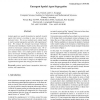Free Online Productivity Tools
i2Speak
i2Symbol
i2OCR
iTex2Img
iWeb2Print
iWeb2Shot
i2Type
iPdf2Split
iPdf2Merge
i2Bopomofo
i2Arabic
i2Style
i2Image
i2PDF
iLatex2Rtf
Sci2ools
IAT
2008
IEEE
2008
IEEE
Emergent Spatial Agent Segregation
Animat agents are usually formulated as spatially located agents that interact according to some microscopic behavioural rules. We use our predator-prey animat model to explore spatial segregation and other self-organising effects. We compare the emergent macroscopic behaviour with that of non-intelligence models such as those governed solely by microscopic statistical mechanics rules. We report on an emergent separation of sub-species amongst our prey animats when a very simple genetic marker is used and a microscopic breeding preference is introduced. We discuss some quantitative metrics such as the spatial density of animats and the density-density correlation function and how these can be used to categorize the different selforganisational regimes that emerge from the model.
Emergent Macroscopic Behaviour | IAT 2008 | Intelligent Agent | Microscopic Behavioural Rules | Microscopic Statistical Mechanics |
| Added | 29 May 2010 |
| Updated | 29 May 2010 |
| Type | Conference |
| Year | 2008 |
| Where | IAT |
| Authors | Kenneth A. Hawick, Chris Scogings |
Comments (0)

